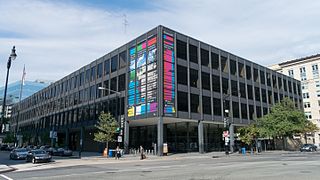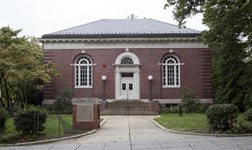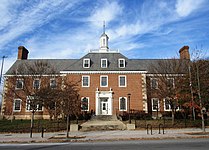
Takoma Park is a city in Montgomery County, Maryland, United States. It is a suburb of Washington, and part of the Washington metropolitan area. Founded in 1883 and incorporated in 1890, Takoma Park, informally called "Azalea City", is a Tree City USA and a nuclear-free zone. A planned commuter suburb, it is situated along the Metropolitan Branch of the historic Baltimore and Ohio Railroad, just northeast of Washington, D.C., and it shares a border and history with the adjacent Washington, D.C. neighborhood of Takoma. It is governed by an elected mayor and six elected councilmembers, who form the city council, and an appointed city manager, under a council-manager style of government. The city's population was 17,629 at the 2020 census.

Northwest is the northwestern quadrant of Washington, D.C., the capital of the United States, and is located north of the National Mall and west of North Capitol Street. It is the largest of the four quadrants of the city, and it includes the central business district, the Federal Triangle, and the museums along the northern side of the National Mall, as well as many of the District's historic neighborhoods.

Friendship Heights is an urban commercial and residential neighborhood in northwest Washington, D.C., and southern Montgomery County, Maryland. Though its borders are not clearly defined, Friendship Heights consists roughly of the neighborhoods and commercial areas around Wisconsin Avenue north of Fessenden Street NW and Tenleytown to Somerset Terrace and Willard Avenue in Maryland, and from River Road in the west to Reno Road and 41st Street in the east. Within Maryland west of Wisconsin Avenue is the Village of Friendship Heights, technically a special taxation district.
Advisory Neighborhood Commissions (ANCs) are bodies of local government in the District of Columbia, the capital city of the United States. The ANC system was created in 1974 through a referendum in the District of Columbia Home Rule Act. The first elections for Advisory Neighborhood Commissioners were held in the fall of 1975, and commissions began operating in 1976. Congressman Don Fraser (D-Minn) and D.C. resident Milton Kotler helped to draft the ANC language in the Home Rule Act based on the success of Adams Morgan Organization (AMO) in Adams Morgan and on a 1970 report of the Minneapolis Citizen League, as well as on related neighborhood corporations in Pittsburgh; Brooklyn, New York; Chicago; and Columbus, Ohio.

Chevy Chase is a neighborhood in northwest Washington, D.C. It borders Chevy Chase, Maryland.

Neighborhoods in Washington, D.C., United States are distinguished by their history, culture, architecture, demographics, and geography. The names of 131 neighborhoods are unofficially defined by the D.C. Office of Planning. Neighborhoods can be defined by the boundaries of wards, historic districts, Advisory Neighborhood Commissions, civic associations, and business improvement districts (BIDs); these boundaries will overlap. The eight wards each elect a member to the Council of the District of Columbia and are redistricted every ten years.

Takoma, Washington, D.C., is a neighborhood in Washington, D.C. It is located in Advisory Neighborhood Commission 4B, in the District's Fourth Ward, within the northwest quadrant. It borders the city of Takoma Park, Maryland.

The Martin Luther King Jr. Memorial Library (MLKML) is the central facility of the District of Columbia Public Library (DCPL), it was constructed and named in honor of the American civil rights leader Dr. Martin Luther King Jr. It is located in the 901 G St. NW in Downtown Washington, D.C., with its main entrance between 9th and 10th St. in the opposite corner of Gallery Place station, and the Smithsonian American Art Museum. The library is located in and around the Chinatown, Mount Vernon Square, and Penn Quarter neighborhoods.

New Hampshire Avenue is a diagonal avenue in Washington, D.C., beginning at the Kennedy Center and extending northeast for about 5 miles (8 km) and then continuing into Maryland where it is designated Maryland Route 650. New Hampshire Avenue, however, is not contiguous. It stops at 15th and W Streets NW and resumes again on the other side of Columbia Heights at Park Road NW, a few blocks from Georgia Avenue. New Hampshire Avenue passes through several Washington neighborhoods including Foggy Bottom, Dupont Circle, Petworth and Lamond-Riggs.

Washington Highlands is a residential neighborhood in Southeast Washington, D.C., in the United States. It lies within Ward 8.

The District of Columbia has a mayor–council government that operates under Article One of the United States Constitution and the District of Columbia Home Rule Act. The Home Rule Act devolves certain powers of the United States Congress to the local government, which consists of a mayor and a 13-member council. However, Congress retains the right to review and overturn laws created by the council and intervene in local affairs.
The Mount Pleasant Library at 1600 Lamont Street, NW in Washington, DC is a branch of the District of Columbia Public Library System that opened in May 1925, and is the third oldest public library building still in use in Washington.

The following outline is provided as an overview of and topical guide to District of Columbia:

Juanita E. Thornton/Shepherd Park Neighborhood Library is part of the District of Columbia Public Library (DCPL) System. It was opened to the public on July 29, 1990. The library was named in honor of Juanita E. Thornton, a teacher and community activist.

Francis A. Gregory Neighborhood Library is part of the District of Columbia Public Library (DCPL) System. It was originally opened to the public in 1961. A new building on the same site, designed by award-winning architect David Adjaye, opened on June 19, 2012.

Bellevue/William O. Lockridge Neighborhood Library is part of the District of Columbia Public Library (DCPL) System. It was originally opened to the public in 1959. It was renovated with a design by British architect David Adjaye and named after activist William O'Neal Lockridge.

The Takoma Park Neighborhood Library is part of the District of Columbia Public Library (DCPL) System. It was opened to the public in 1911.

The Lamond-Riggs/Lillian J. Huff Neighborhood Library is a branch of the District of Columbia Public Library in the Queens Chapel neighborhood of Washington, D.C. It is located at 5401 South Dakota Avenue NE. Residents had requested a library for the area as early as 1957; the current building opened in 1983 at a cost of $2 million.

The Southeast Neighborhood Library is a branch of the District of Columbia Public Library in the Capitol Hill neighborhood of Washington, D.C. It is located at 403 7th Street SE. Designed by architect Edward Lippincott Tilton in the neoclassical style, it opened in 1922 and is one of three Carnegie libraries in Washington. As of 2019, the city planned a $23.5 million renovation of the library starting in 2021. The building was listed on the National Register of Historic Places in 2021.






























